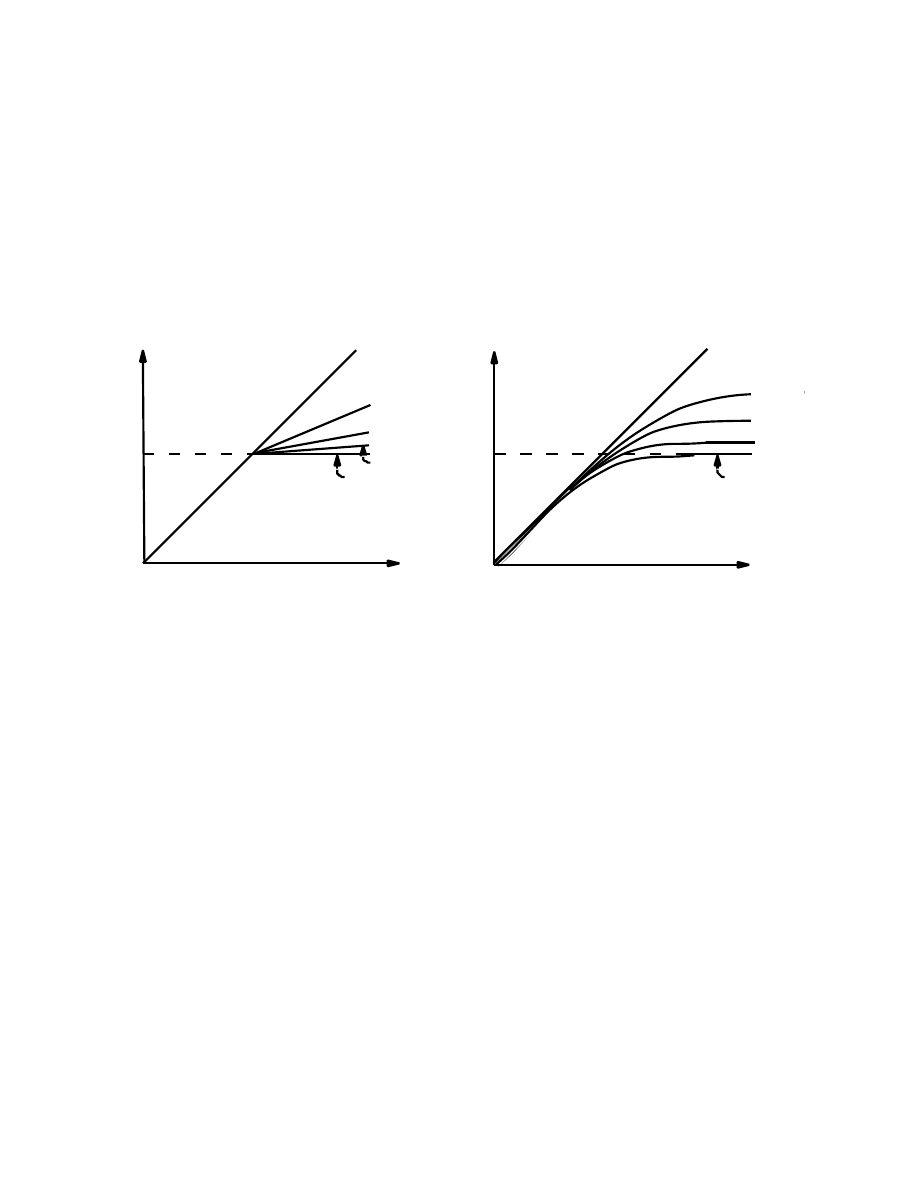ВУЗ: Казахская Национальная Академия Искусств им. Т. Жургенова
Категория: Учебное пособие
Дисциплина: Не указана
Добавлен: 03.02.2019
Просмотров: 12329
Скачиваний: 6

S
slew rate: Slew rate is a common specification for transient behavior of electronic devices. It is
expressed in V/µs and tells how fast the output of the device rises, given a rapidly rising in-
put. A slew rate of 40V/µs means that it would take one µs for the output to change by 40V.
Since studio equipment typically operates on +15V and -15V internally, its output can never
really swing 40V. In reality, it might go 5V in
1
8
µs
.
An audio device will have a maximum
slew rate above which it cannot operate. This maximum limits the high-frequency power out-
put of amplifiers and limits the high-level, high-frequency handling capacity in all audio de-
vices. Too low a maximum slew rate results in slew-induced distortion, called transient inter-
modulation distortion (TIM).
slip cue: In playing records, the process of locating the first note of music in any band, hold-
ing the disc motionless while the turntable rotates beneath it, then releasing the record so that
music begins precisely when the disc is released. This is done either to effect precise segues, or
to align the rhythm of one record with another one already playing, called mixing.
slope: See rolloff slope.
slop print: See workprint. Also called a dirty dupe or scratch print.
small-room X-Curve: See X-Curve.
small signal bandwidth: The bandwidth an audio device will exhibit at relatively low signal
levels. Most audio devices will have a wider frequency range at low signal levels than high
signal levels because of such effects as slew limiting. See power bandwidth.
smart slate: Timecode slate that contains a timecode generator. A “dumb” slate must be fed
timecode continuously.
smart sync: The ability of some A/D-D/A converters, digital recorders, or other digital de-
vices to automatically sync to word clock.
SMDI: SCSI Musical Data Interchange. A specification for sending MIDI sample dumps over
the SCSI bus. This requires that the computer be connected to a sampler via both SCSI and
MIDI interfaces. See SDS.
SMF: Standard MIDI File. A file format for transferring data between sequencers and between
Macs and PCs. Sequence data is stored on disk in one of three formats: Type 0 packages all
data into a single track, regardless of the number of original tracks. Type 1 retains the track
layout, although the tempo and time signature of all tracks will be those of track one. Type 2 is
the same as Type 1, except that each track keeps its own tempo and time signature, but is sel-
dom implemented. The files include information called meta events about such things as track
and instrument names, copyright notice, tempo change, SMPTE timecode offset, lyrics and key
and time signatures. The time between sequence events is encoded in delta time messages of
between one and four bytes.
SMP: Turtle Beach’s SampleVision™ audio file format. Typically encountered as
FILENAME.SMP
.
SMPTE: Society of Motion Picture and Television Engineers. Also used as an abbreviation for
SMPTE timecode.
SMPTE curve: An equalization curve standard in the U.S. for 35mm mag film.

S
SMPTE leader: See SMPTE Universal leader.
SMPTE sync track: A square wave recorded onto an audio track. Note that this is only possi-
ble with digital audio, so for the most reliable results when transferring audio, use jam sync.
See also sync track.
SMPTE timecode: A high-frequency timing reference signal developed by SMPTE and used
for synchronizing film and videotape to audio tape and software-based playback systems.
SMPTE is a tempo-independent code which comprises a continuous stream of absolute
positional data, so if a short section of code gets lost or corrupted, the system knows exactly
where it’s supposed to be the next time a piece of valid code is read. Usually generated at the
picture source, i.e., the SMPTE master clock generator that drives the film or television camera
system, the signal is recorded onto the videotape or along the edge of the motion picture film,
and sent simultaneously to the audio recorder. The signal contains encoded numerical infor-
mation, allowing the same point in film or tape time to be located on the separate strips of
film/videotape and audio tape, for proper alignment or ADR. The playback operator can se-
lect a SMPTE timecode number that instructs videotape and audiotape machines to locate a
certain point and begin playing in sync from that absolute location.
Timecode data are in the form of a timecode address (TCA), which make up the HH:MM:SS:FF
part of the timecode word, where HH is a two-byte number for absolute time hour, MM is
minutes, SS is seconds, and FF denotes the absolute frame number. See frame, jam sync, LTC,
MTC, BITC, VITC, and bi-phase modulation. Also called longitudinal timecode. As opposed to
speed-only sync codes such as pilot tone, FSK, and DIN sync.
SMPTE Universal leader: Designed primarily for video, the leader, after Picture Start, features
a sweep hand counting down from eight seconds. See Academy leader.
S/N: See signal-to-noise ratio.
snake: An assembly of cables or wires often used to carry several channels of audio signals
between two points, such as from the stage to a mixer. The most commonly used snakes con-
sist of several sets of balanced line connections, with a snake box at the mic end, fitted with the
appropriate number of XLR -type microphone sockets, the long, large, multiwire cable on
which the individual channels are carried, terminating in a large modular connector for con-
nection to a distribution panel which is, in turn, connected to a power amplifier or preamp.
Also called multicore or rope. A snake box is also called a stage box.
snake box: See snake.
snake track: A special optical soundtrack on a test film for adjusting the alignment of the optical
sound system in a motion picture projector equipped to reproduce SVA soundtracks.
snapshot automation: A form of MIDI-controlled mixer automation in which the controlling
device records the instantaneous settings (the snapshot) for all levels and panpots, and recalls
these settings on cue.
SND: See SouND resource.
SNR: See signal-to-noise ratio.

S
soft clipping: A form of clipping where the edges of the clipped waveform are rounded rather
than sharp. Soft clipping is much easier on the ears and tweeters than hard, as it contains
much less very high frequency energy. Compare with hard clipping.
soft knee compression: The output of a compressor whose gain reduction is brought in pro-
gressively over a range of input signal values, such as over 10db or so, starting a few dBs be-
low the threshold. When the input signal amplitude comes within the range of the threshold,
the compressor starts to apply again reduction, but with a very low ratio setting. As the input
level increases, the compression is automatically increased until, at the threshold level, the ra-
tio becomes infinite. Compare with hard knee compression.
Output Level, dB
Input Level, dB
Hard-Knee Compression
Input Level, dB
Output Level, dB
1:1 Ratio
2:1 Ratio
4:1 Ratio
8:1 Ratio
Soft-Knee Compression
Threshold
Threshold
1:1 Ratio
2:1 Ratio
4:1 Ratio
8:1 Ratio
Hard limiting
Hard limiting
soft pedal: (1) On a piano, the pedal for producing a softer sound, accomplished by shifting
the action sideways so that fewer strings per note are struck. On less expensive instruments,
the hammers are simply moved closer to the strings. (2) A MIDI Controller Change message
assigned to a parameter in a synthesizer which reproduces the function of a soft pedal.
Software Thru: When Software Thru is On, MIDI data at the sequencer’s MIDI input passes
through to the output. When it is Off, MIDI data at the input does not appear at the output.
See also MIDI Thru, Local Control.
Local Control On, Software Through On: Not recommended as this setting can cause note-doubling.
Local Control On, Software Thru Off: Recommended mode. The sequencer records data, and you hear
what you play on the keys.
Local Control Off, Software Thru On: Alternate recommended mode. The keyboard acts like a master
controller, but you’ll only hear what you play if Software Thru is On and directing the input signal to a
specific channel, i.e., the one that feeds the sound you want to hear. Most sequencers let you choose
whether Thru echoes data on the incoming channel or directs this data to a different channel.
Local Control Off, Software Thru Off: Not recommended. This allows the playback of tracks already
recorded into the sequencer, but it is not possible to monitor what is being played or recorded.
solid-state: A term which indicates that a device uses semiconductor (IC) devices, instead of
vacuum tubes. Note that tubes in the UK are called valves.

S
solo: (1) A feature on a mixing console that automatically routes one or more selected channels
to the recording monitors or headphones without disturbing the main audio mix. Some studio
consoles use destructive solo, where the soloed instruments replace the mix in the main stereo
bus. On sound reinforcement mixing consoles, solo functions are normally routed to head-
phones (non-destructive solo), allowing the engineer to check console channels while the con-
cert is in progress. In-place solo is a function that permits the user to hear individual channels,
but also in the correct stereo perspective, as defined by that channel’s pan control. (2) A section
of music which gives particular prominence to one musician.
solo-in-place: In a recording console, the function that allows all input signals to be muted ex-
cept one, permitting that one to pass through to the monitor or mix buses exactly as heard in
the composite mix, preserving its level, equalization and other processing and stereo position.
sone: A standardized unit of perceived loudness. A graph of sones vs. SPL shows, for any con-
stant SPL, the relative loudness the ear perceives at each frequency, i.e., the inverse of the equal
loudness curves.
song: (1) Strictly, a piece of solo vocal music, with or without accompaniment, and of short
duration. In popular music, this has come to mean any music which is sung. (2) A synonym
for a sequence, i.e., a selection of MIDI performance data recorded on a sequencer.
Song Position Pointer (SPP): A System Common MIDI message that tells a device how many
sixteenth-notes have passed since the beginning of the MIDI sequence file. An SPP message is
generally sent in conjunction with a Continue message in order to start playback from the
middle of a song. Alternately, by reading a sync signal (such as FSK or SMPTE timecode) re-
corded on a tape track and converting it to an SPP message, a synchronizer could instruct a
MIDI sequencer to start playing a sequence at a given location and keep it in sync with the
tape.
Song Select: A System Common MIDI message which outputs the number of the song (se-
quence) which a sequencer or drum machine should play.
soprano: A high human or instrumental voice above the alto in pitch, ranging from about
middle-C upwards. The very highest instruments in a given family are sometimes called so-
pranino, such as sopranino recorder. Soprano parts are notated with the treble clef.
sostenuto pedal: A pedal found on a grand piano and mimicked on some synthesizers, with
which notes are sustained only if they are already being held on the keyboard at the moment
when the pedal is pressed. Compare with the sustain pedal.
sound: The vibration of some physical object, resulting in a pressure front moving through air
molecules at 1130 feet per second, a zone of high pressure followed by a zone of low pressure.
All sounds can be analyzed as having a number of specific characteristics: pitch (frequency),
timbre (tone), amplitude (volume) and envelope (the shape of the sound as it changes over time.)
What distinguishes one sound from another is the combination of harmonics and other partials
that are present in the sound and how the amplitudes of the various partials change over time.
sound blanket: A think, sound-absorbent blanket, often a mover’s quilt, that can be spread on
the floor of a set or hung just outside camera range. Its purpose is to damp unwanted reflec-
tions, echoes, or reverberation which would affect location sound, or to keep unwanted outside
sounds from reaching a microphone during shooting of film or videotape.

S
sound board: A separate, resonant piece of wood in a piano, located under the string assem-
bly. The sound board reflects the sounds back from the bottom of the piano case and out away
from the piano. The quality and shape of the sound board give each piano a distinct timbre.
soundcard: A circuit board that installs inside a computer, adding new sound capabilities.
These capabilities can include an FM or wavetable synthesizer and audio inputs and outputs.
MIDI inputs and outputs are also normally included.
sound check: A diagnostic procedure carried out before a performance or recording, particu-
larly when amplified instruments and/or a PA system is used to ensure that all of the equip-
ment is in working order, and that sound levels are set correctly.
Sound Controller Message: One of ten defined MIDI Controller Change messages which are
assigned to general-purpose parameters in a synthesizer or effects unit and allow real-time edit-
ing of sound quality and effects from a sequencer.
sound cutting: See track laying.
sound designer: (1) Most commonly, the person who creates special sound effects for film;
originally, the person assigned responsibility for the over sound of the film, and who super-
vises the sound editing and re-recording. (2)
SoundDesigner™, a popular digital synthesis pro-
gram.
SoundEdit: A format used on the MacRecorder which became a standard for exchanging 8-bit
mono or stereo sound files at four sampling rates from 5.5kHz to 22.255kHz; compression is
available for mono files at 3:1, 4:1. 6:1, and 8:1. Newer SoundEdit software supports 16-bit
sounds with sampling rates up to 64kHz.
sound field: The area and/or pattern of air pressure disturbance caused by the compression
and rarefaction of energy in the AF band.
Soundfield microphone: An extension of MS recording for ambisonic recording. This tech-
nique captures and reproduces true surround-sound, with height information as well as 360˚
horizontal imaging, as opposed to the artificial spatial position of various cinema surround
systems. This is accomplished by six separate capsules which allow separate recording of left-
right, front-rear, and up-down sound sources. Most use of these microphones is for stun-
ningly accurate stereo recording.
sounding: The act of recording sound on a mag release print.
sound intensity: Defined as a measure of the net flow of acoustic energy in a sound field. The
units are watts per square meter, and because the energy moves in a particular direction,
sound intensity is a vector quantity, i.e., it has magnitude and direction. Sound intensity is not
able to be measured directly, and it should not be confused with SPL which is what a sound
level meter measures.
Sound Manager: A part of the Mac operating system that handles audio functionality such as
input, mixing, and playback. Currently the Sound Manager supports only mono or stereo re-
cording and playback at 16-bit, 48kHz resolution. Most Mac audio cards do not use Sound
Manager for this reason, achieving both increased bit-depth and sampling resolution. See also
WAV/multi-WAV drivers.